Performance and Lifecycle of Hot Asphalt Mix Modified with Low-Percentage Polystyrene and Polybutadiene Compounds
Abstract
1. Introduction
2. Materials and Methodologies
- Road bitumen 35/50;
- Road bitumen 50/70;
- SBS polymer;
- Reference road bitumen 10/40–65;
- Natural crushed aggregates (several sources of aggregates used melaphyre, andesite, and dolomite filer).
3. Modificant Testing—FT-IR Spectroscopy
4. Bitumen and Modificant Testing—Penetration, Softening Point, and Elastic Recovery Test
- Road bitumen 50/70 + 3% SBS;
- Road bitumen 10/40–65 reference.
5. Hot Asphalt Mix Testing—The Wheel Tracking Test and the Fatigue Test
- Road bitumen 50/70 + 3% modifier;
- Road bitumen 10/40–65 reference.
- Mixture 1 (SMA11)—length 400 mm, width 300 mm, height 40 mm, weight 11.43 kg, volume 0.0048 m3, and density 2381 kg/m3. The results for Mixture 1 are shown in Table 3.
- Mixture 2 (AC11)—length 400 mm, width 300 mm, height 41 mm, weight 11 kg, volume 0.0049 m3, and density 2236 kg/m3. The results for Mixture 2 are shown in Table 4.
- Mixture 3 (AC22)—length 400 mm, width 300 mm, height 80 mm, weight 21.62 kg, volume 0.0096 m3, and density 2252 kg/m3. The results for Mixture 3 are shown in Table 5.
- The wheel-tracking slope (WTS), calculated as the mean rate at which the rut depth increased with repeated passes of a loaded small-sized device, model B, in millimeters.
- The rut depth (RD) of the material using a small-sized device, in millimeters.
- The mean proportional rut depth (PRD) for the material using a small-sized device, in %.
- Resistance to fatigue (ɛ6).
6. Lifecycle Study—Bearing Capacity
- AC22 with road bitumen 50/70 (unmodified);
- AC22 with road bitumen 50/70 + 3% SBS;
- AC22 with road bitumen 10/40–65 used as a reference mixture.
6.1. Service Life of the Pavement Based on the Different Fatigue Parameters of the Asphalt Mixtures
- AC22 with 50/70 bitumen (unmodified) − 3.57 × 106 DAL;
- AC22 with 50/70 bitumen + 3% modifier − 4.80 × 106 DAL;
- AC22 with 10/40–65 reference bitumen − 5.99 × 106 DAL.
6.2. Lifecycle Study—Emissions Analysis Comparison
6.3. Pavement Performance
- AC22 with the bitumen 10/40–65 PMB as the reference mixture reached a 14 mm rut in 4.80 × 106 DAL, which is about 80% of its designed lifetime;
- AC22 with the bitumen 50/70 + 3% SBS reached a critical rut failure state at 4.32 × 106 DAL at 95% of its designed lifetime;
- AC22 with the bitumen 50/70 reached a critical rut failure state at 3.36 × 106 DAL at 112% of its designed lifetime.
6.4. Emmisions Production and Savings
- Nitrous oxide NOx;
- Sulfur dioxide SO2;
- Carbon dioxide CO29.
7. Discussion
8. Conclusions
- Doubles the elastic recovery value;
- The softening point is 3 °C higher, but with an adverse effect on the penetration, and with a 12% worse penetration value compared to unmodified bitumen.
- Doubles the elastic recovery value;
- The softening point is 2.5 °C higher, with a penetration increase of 20%.
- In SMA11, achieves the same resistance to permanent deformation as SMA with the reference road bitumen 10/40–65.
- In AC11, achieves an increase of 89.9% to permanent deformation as AC11 with the reference road bitumen 10/40–65.
- In AC22, achieves an increase of 76% to permanent deformation as AC11 with the reference road bitumen 10/40–65.
Supplementary Materials
Author Contributions
Funding
Data Availability Statement
Conflicts of Interest
References
- Dirmeier, J.; Paterson, J. Renewal and Rejuvenation of Aging Infrastructure. In Routes/Roads; World Road Association (PIARC): Paris, France, 2022; Volume 394. [Google Scholar]
- Toplis, C.M.; Kidnie, M.; Marchese, A.; Maruntu, C.; Murphy, H.; Sébille, R.; Thomson, S. International Climate Change Adaptation Framework for Road Infrastructure; Special Project No. 2015R03EN; World Road Association—PIARC: La Défense, France, 2015; ISBN 978-2-84060-362-7. Available online: https://www.piarc.org/en/order-library/23517-en-International%20climate%20change%20adaptation%20framework%20for%20road%20infrastructure (accessed on 5 January 2024).
- Remišová, E.; Zatkalíková, V. Evaluation of bituminous binder in relation to resistance to permanent deformation. Procedia Eng. 2016, 153, 584–589. [Google Scholar] [CrossRef]
- Tayfur, S.; Ozen, H.; Aksoy, A. Investigation of rutting performance of asphalt mixtures containing polymer modifiers. Constr. Build. Mater. 2007, 21, 328–337. [Google Scholar] [CrossRef]
- Mazurek, G.; Iwański, M. Estimation of Zero Shear Viscosity Versus Rutting Resistance Parameters of Asphalt Concrete. Procedia Eng. 2016, 161, 30–35. [Google Scholar] [CrossRef]
- Song, S.; Yeom, C. Reduction of Plastic Deformation in Heavy Traffic Intersections in Urban Areas. Sustainability 2021, 13, 4002. [Google Scholar] [CrossRef]
- Alaswadko, N.; Hassan, R. Rutting progression models for light duty pavements. Int. J. Pavement Eng. 2018, 19, 37–47. [Google Scholar] [CrossRef]
- Coleri, E.; Tsai, B.W.; Monismith, C.L. Pavement rutting performance prediction by integrated Weibull approach. Transp. Res. Rec. 2008, 2087, 120–130. [Google Scholar] [CrossRef]
- Buczyński, P.; Šrámek, J.; Mazurek, G. The Influence of Recycled Materials on Cold Mix with Foamed Bitumen Properties. Materials 2023, 16, 1208. [Google Scholar] [CrossRef] [PubMed]
- Mazurek, G.; Šrámek, J.; Buczyński, P. Composition Optimisation of Selected Waste Polymer-Modified Bitumen. Materials 2022, 15, 8714. [Google Scholar] [CrossRef] [PubMed]
- Pérez, I.; Medina, L.; Gallego, J. Plastic deformation behaviour of pavement granular materials under low traffic loading. Granul. Matter. 2010, 12, 57–68. [Google Scholar] [CrossRef]
- Li, W.; Cao, W.; Ren, X.; Lou, S.; Liu, S.; Zhang, J. Impacts of Aggregate Gradation on the Volumetric Parameters and Rutting Performance of Asphalt Concrete Mixtures. Materials 2022, 15, 4866. [Google Scholar] [CrossRef]
- Porto, M.; Caputo, P.; Loise, V.; Eskandarsefat, S.; Teltayev, B.; Oliviero Rossi, C. Bitumen and bitumen modification: A review on latest advances. Appl. Sci. 2019, 9, 742. [Google Scholar] [CrossRef]
- Paliukaite, M.; Vaitkus, A.; Zofka, A. Evaluation of Bitumen Fractional Composition Depending on the Crude Oil Type and Production Technology. In Environmental Engineering. Proceedings of the International Conference on Environmental Engineering; ICEE: La Vergne, TN, USA, 2014; Volume 9, pp. 1–7. [Google Scholar] [CrossRef]
- Subhy, A. Advanced analytical techniques in fatigue and rutting related characterisations of modified bitumen: Literature review. Constr. Build. Mater. 2017, 156, 28–45. [Google Scholar] [CrossRef]
- Bala, N.; Kamaruddin, I.; Napiah, M.; Danlami, N. Rheological and Rutting Evaluation of Composite Nanosilica/Polyethylene Modified Bitumen. In Proceedings of the IOP Conference Series: Materials Science and Engineering, Penang, Malaysia, 11–13 March 2017; IOP Publishing: Bristol, UK, 2017; Volume 201, p. 012012. [Google Scholar] [CrossRef]
- Singh, M.; Kumar, P.; Maurya, M.R. Strength characteristics of SBS modified asphalt mixes with various aggregates. Constr. Build. Mater. 2013, 41, 815–823. [Google Scholar] [CrossRef]
- Sengoz, B.; Isikyakar, G. Evaluation of the properties and microstructure of SBS and EVA polymer modified bitumen. Constr. Build. Mater. 2008, 22, 1897–1905. [Google Scholar] [CrossRef]
- Fernandes, M.R.S.; Forte, M.M.C.; Leite, L.F.M. Rheological evaluation of polymer-modified asphalt binders. Mater. Res. 2008, 11, 381–386. [Google Scholar] [CrossRef]
- Yetkin, Y. Polymer modified asphalt binders. Constr. Build. Mater. 2007, 21, 66–72. [Google Scholar] [CrossRef]
- Airey, G.D. Rheological properties of styrene butadiene styrene polymer modified road bitumens☆. Fuel 2003, 82, 1709–1719. [Google Scholar] [CrossRef]
- Schaur, A.; Unterberger, S.; Lackner, R. Impact of molecular structure of SBS on thermomechanical properties of polymer modified bitumen. Eur. Polym. J. 2017, 96, 256–265. [Google Scholar] [CrossRef]
- Lu, X.; Isacsson, U.; Ekblad, J. Phase separation of SBS polymer modified bitumens. J. Mater. Civ. Eng. 1999, 11, 51–57. [Google Scholar] [CrossRef]
- Zhu, J.; Lu, X.; Kringos, N. Experimental investigation on storage stability and phase separation behaviour of polymer-modified bitumen. Int. J. Pavement Eng. 2018, 19, 832–841. [Google Scholar] [CrossRef]
- Zhu, J.; Lu, X.; Balieu, R.; Kringos, N. Modelling and numerical simulation of phase separation in polymer modified bitumen by phase-field method. Mater. Des. 2016, 107, 322–332. [Google Scholar] [CrossRef]
- Kok, B.V.; Yalcin BYilmaz, M.; Yalcin, E. Performance evaluation of bitumen modified with styrene–isoprene-styrene and crumb rubber compound. Constr. Build. Mater. 2022, 344, 128304. [Google Scholar] [CrossRef]
- Khordehbinan, M.; Kaymanesh, M.R. Chemical analysis and middle-low temperature functional of waste polybutadiene rubber polymer modified bitumen. Pet. Sci. Technol. 2020, 38, 8–17. [Google Scholar] [CrossRef]
- Singh, S.K.; Kumar, Y.; Ravindranath, S.S. Thermal degradation of SBS in bitumen during storage: Influence of temperature, SBS concentration, polymer type and base bitumen. Polym. Degrad. Stab. 2018, 147, 64–75. [Google Scholar] [CrossRef]
- De Carcer, Í.A.; Masegosa, R.M.; Viñas, M.T.; Sanchez-Cabezudo, M.; Salom, C.; Prolongo, M.G.; Páez, A. Storage stability of SBS/sulfur modified bitumens at high temperature: Influence of bitumen composition and structure. Constr. Build. Mater. 2014, 52, 245–252. [Google Scholar] [CrossRef]
- EN 12591:2009; Bitumen and Bituminous Binders—Specifications for Paving Grade Bitumens. European Committee for Standardization (CEN); European Committee: Brussels, Belgium, 2009.
- EN 14023:2010; Bitumen and Bituminous Binders—Specification Framework for Polymer Modified Bitumens. European Committee for Standardization (CEN); European Committee: Brussels, Belgium, 2010.
- EEN 12697-33:2019; Bituminous Mixtures—Test Method—Part 33: Specimen Prepared by Roller Compactor. European Committee for Standardization (CEN); European Committee: Brussels, Belgium, 2019.
- Bernier, A.; Zofka, A.; Yut, I. Laboratory Evaluation of Rutting Susceptibility of Polymer-Modified Asphalt Mixtures Containing Recycled Pavements. Constr. Build. Mater. 2012, 31, 58–66. [Google Scholar] [CrossRef]
- Canto, L.B.; Mantovani, G.L.; deAzevedo, E.R.; Bonagamba, T.J.; Hage, E.; Pessan, L.A. Molecular Characterization of Styrene-Butadiene-Styrene Block Copolymers (SBS) by GPC, NMR, and FTIR. Polym. Bull. 2006, 57, 513–524. [Google Scholar] [CrossRef]
- Luo, S.; Tian, J.; Liu, Z.; Lu, Q.; Zhong, K.; Yang, X. Rapid Determination of Styrene-Butadiene-Styrene (SBS) Content in Modified Asphalt Based on Fourier Transform Infrared (FTIR) Spectrometer and Linear Regression Analysis. Measurement 2020, 151, 107204. [Google Scholar] [CrossRef]
- EN 1426; Bitumen and Bituminous Binders. Determination of Needle Penetration. European Committee for Standardization (CEN); European Committee: Brussels, Belgium, 2015.
- EN 1427; Bitumen and Bituminous Binders. Determination of the Softening Point—Ring and Ball Method. European Committee for Standardization (CEN); European Committee: Brussels, Belgium, 2015.
- EN 13398; Bitumen and Bituminous Binders. Determination of the Elastic Recovery of Modified Bitumen. European Committee for Standardization (CEN); European Committee: Brussels, Belgium, 2018.
- Zhou, F.; Chen Dar-Hao Scullion, T.; Bilyeu, J. Case study: Evaluation of laboratory test methods to characterize permanent deformation properties of asphalt mixes. Int. J. Pavement Eng. 2003, 4, 155–164. [Google Scholar] [CrossRef]
- Morea, F.; Zerbino, R. Wheel tracking test (WTT) conducted under different standards. Study and correlation of test parameters and limits. Mater. Struct. 2015, 48, 4019–4028. [Google Scholar] [CrossRef]
- EN 12697-22; Bituminous Mixtures. Test Methods. Part 22: Wheel Tracking. European Committee for Standardization (CEN); European Committee: Brussels, Belgium, 2020.
- EN 12697-24; Bituminous Mixtures. Test Methods for Hot Mix Asphalt—Part 24: Resistance to Fatigue. European Committee for Standardization (CEN); European Committee: Brussels, Belgium, 2018.
- Mikolaj, J.; Remek, Ľ.; Kozel, M. Road Asset Value Calculation Based on Asset Performance, Community Benefits and Technical Condition. Sustainability 2022, 14, 4375. [Google Scholar] [CrossRef]
- Decký, M.; Drusa, M.; Papán, D.; Šrámek, J. The Relationship between Dynamic and Static Deformation Modulus of Unbound Pavement Materials Used for Their Quality Control Methodology. Materials 2022, 15, 2922. [Google Scholar] [CrossRef] [PubMed]
- Gago, F.; Valletta, A.; Mužík, J. Formulation of a Basic Constitutive Model for Fine-Grained Soils Using the Hypoplastic Framework. Civ. Environ. Eng. 2021, 17, 450–455. [Google Scholar] [CrossRef]
- Šrámek, J.; Kozel, M.; Remek, L.; Mikolaj, J. Evaluation of Bitumen Modification Using a Fast-Reacting SBS Polymer at a Low Modifier Percentage. Materials 2023, 16, 2942. [Google Scholar] [CrossRef]
- Odoki, J.B.; Kerali, H.G.R. Analytical Framework and Model Description. In The Highway Development and Management Series; Association Mondiale de la Route—World Road Association: La Défense, France, 2023; Volume 4, ISBN 2-84060-102-8. [Google Scholar]
- World Road Association—PIARC. HDM-4 Software, version 2.0; World Road Association—PIARC: La Défense, France; Available online: https://www.piarc.org/en/PIARC-knowledge-base-Roads-and-Road-Transportation/Road-Safety-Sustainability/Road-Assets-Management/HDM-4-Software (accessed on 2 October 2023).
- Collings, A.A.; Watkiss, P.R. Development of Environmental Impacts and Energy Balance Models for HDM-4, Final Project Report for the Department for International Development, UK; AEA Technology: Carlsbad, CA, USA, 1998. Available online: https://assets.publishing.service.gov.uk/media/57a08d86e5274a27b20018d1/R7369_final_report_issue_2.pdf (accessed on 2 October 2023).
- Hammerstrom, U. Proposal for a Vehicle Exhaust Model in HDM-4, ISOHDM Supplementary Technical Relationships Study Draft Report; Swedish National Road Administration, Road and Traffic Management Division: Borlange, Sweden, 1995.
- Essen, H.; Fiorello, D.; El Beyrouty, K.; Bieler, C.; van Wijngaarden, L.; Schroten, A.; Parolin, R.; Brambilla, M.; Sutter, D.; Maffii, S. Handbook on the External Costs of Transport–Version 2019—1.1; No. 18.4 K83. 131; Publications Office: Luxembourg, 2020; Available online: https://data.europa.eu/doi/10.2832/51388 (accessed on 2 October 2023).
- Sartori, D.; Catalano, G.; Genco, M.; Pancotti, C.; Sirtori, E.; Vignetti, S.; Del Bo, C. Guide to Cost-Benefit Analysis of Investment Projects. Economic Appraisal Tool for Cohesion Policy 2014–2020; European Commission, Directorate-General for Regional and Urban Policy: Luxembourg, 2014; ISBN 978-92-79-34796-2. [CrossRef]
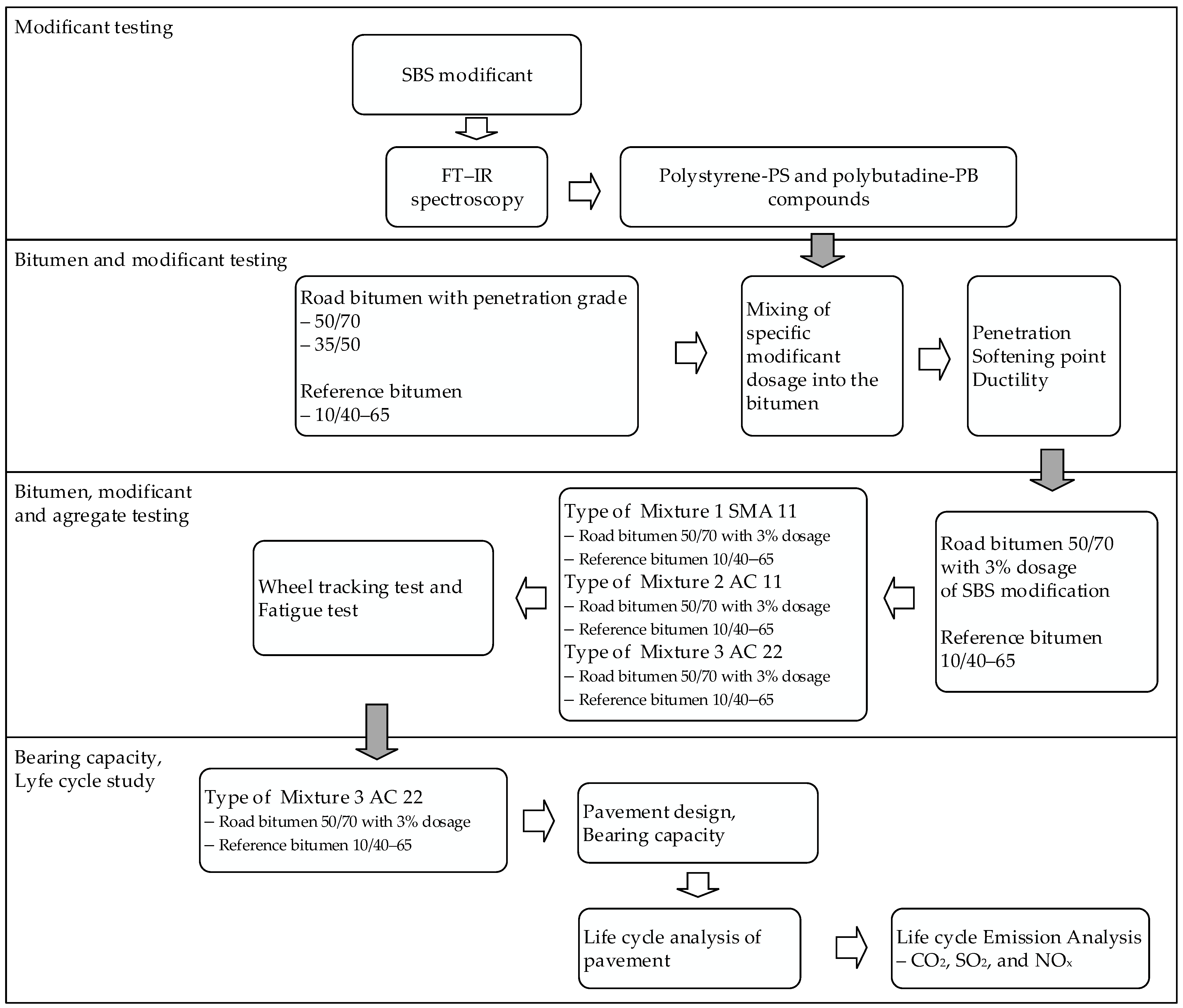
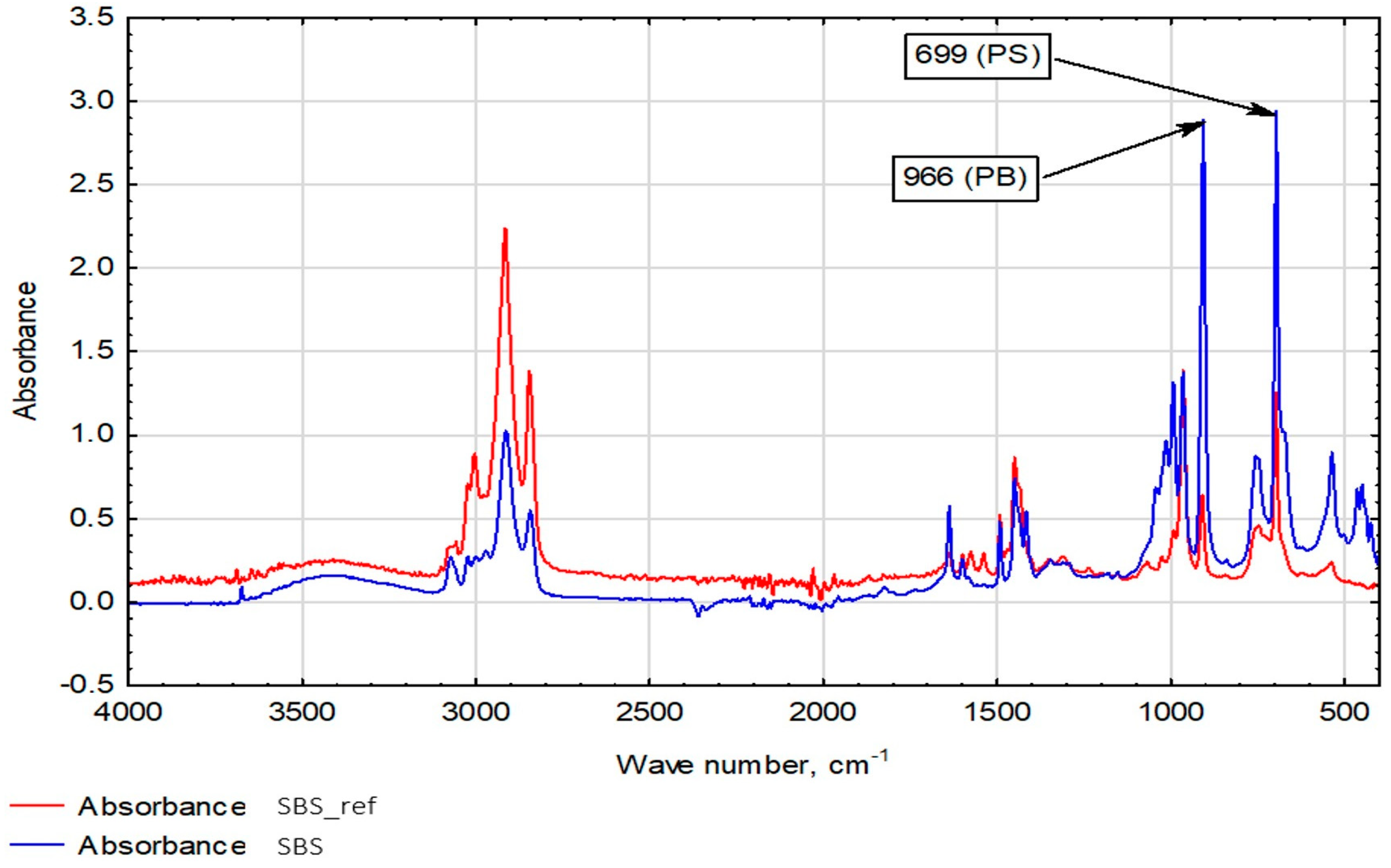
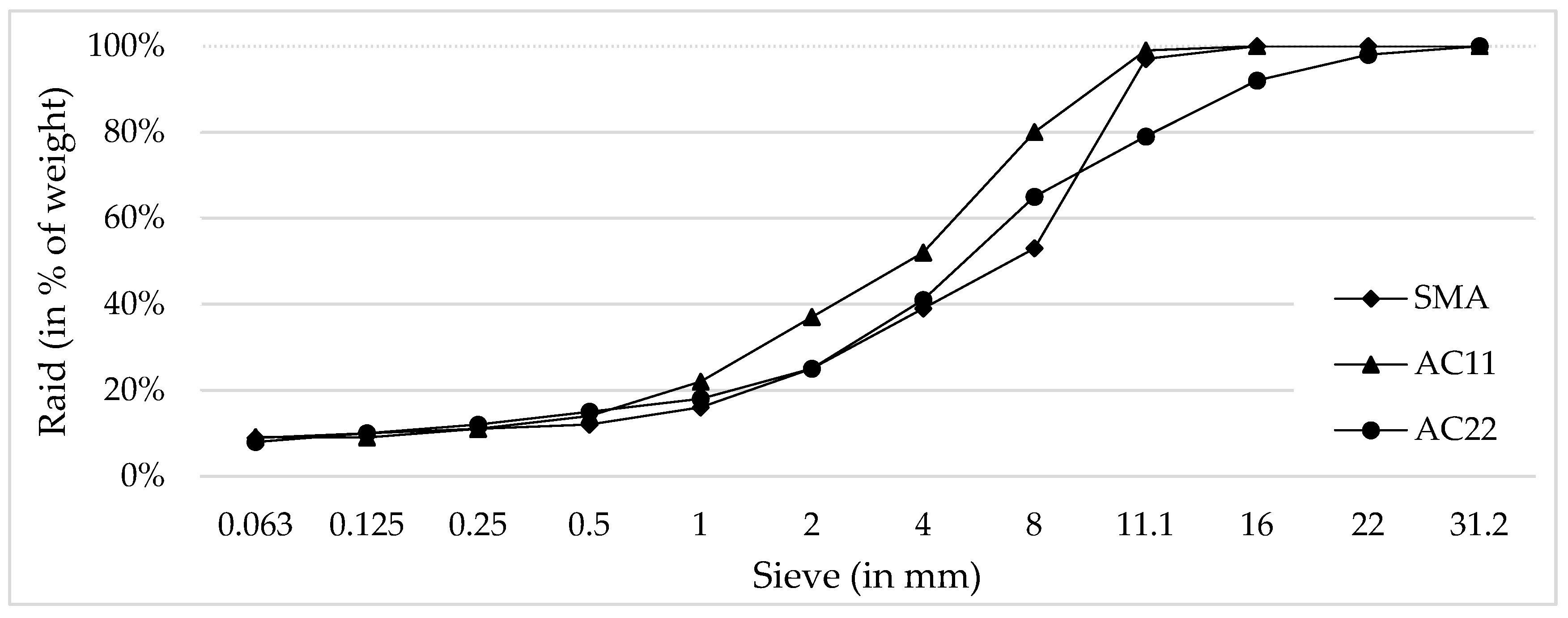
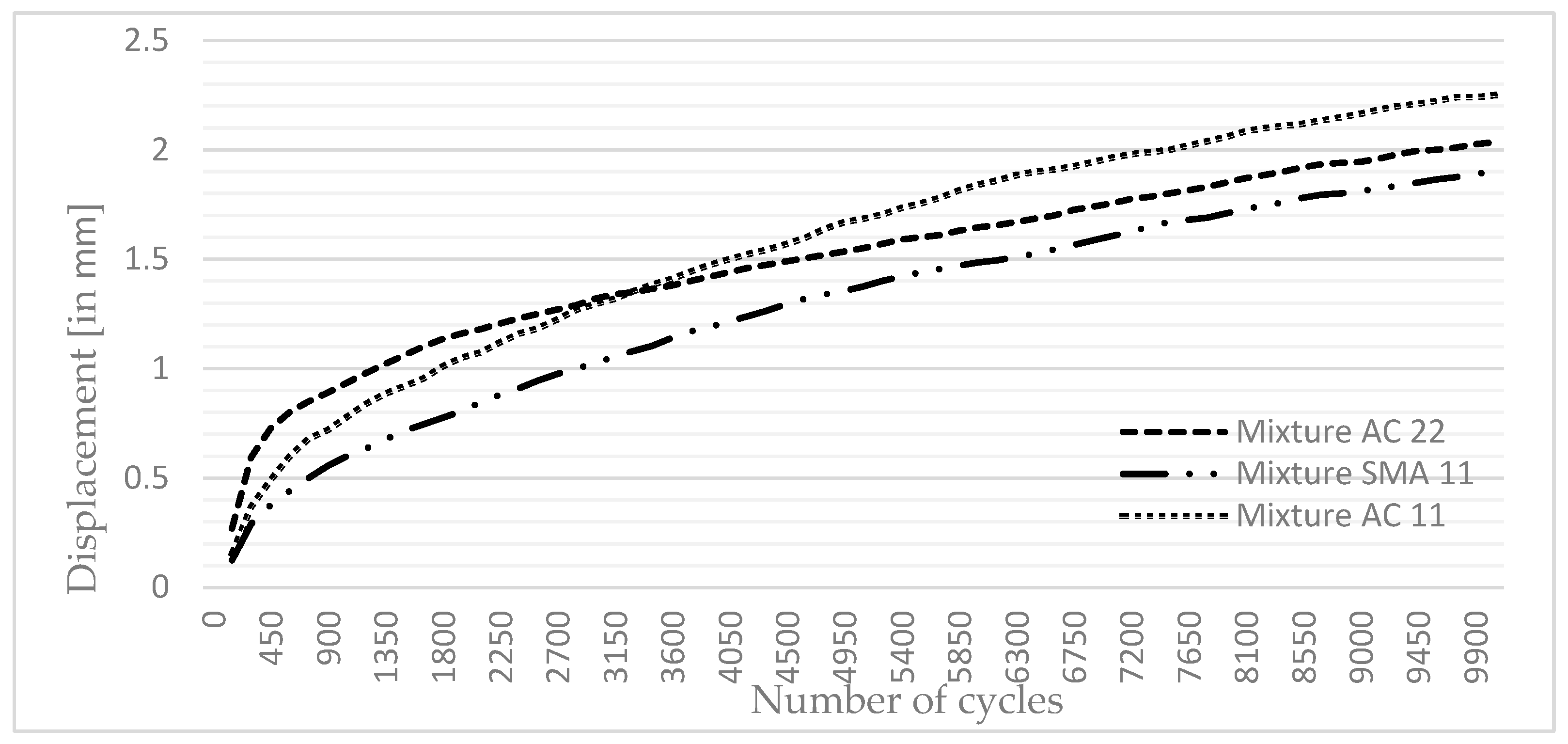


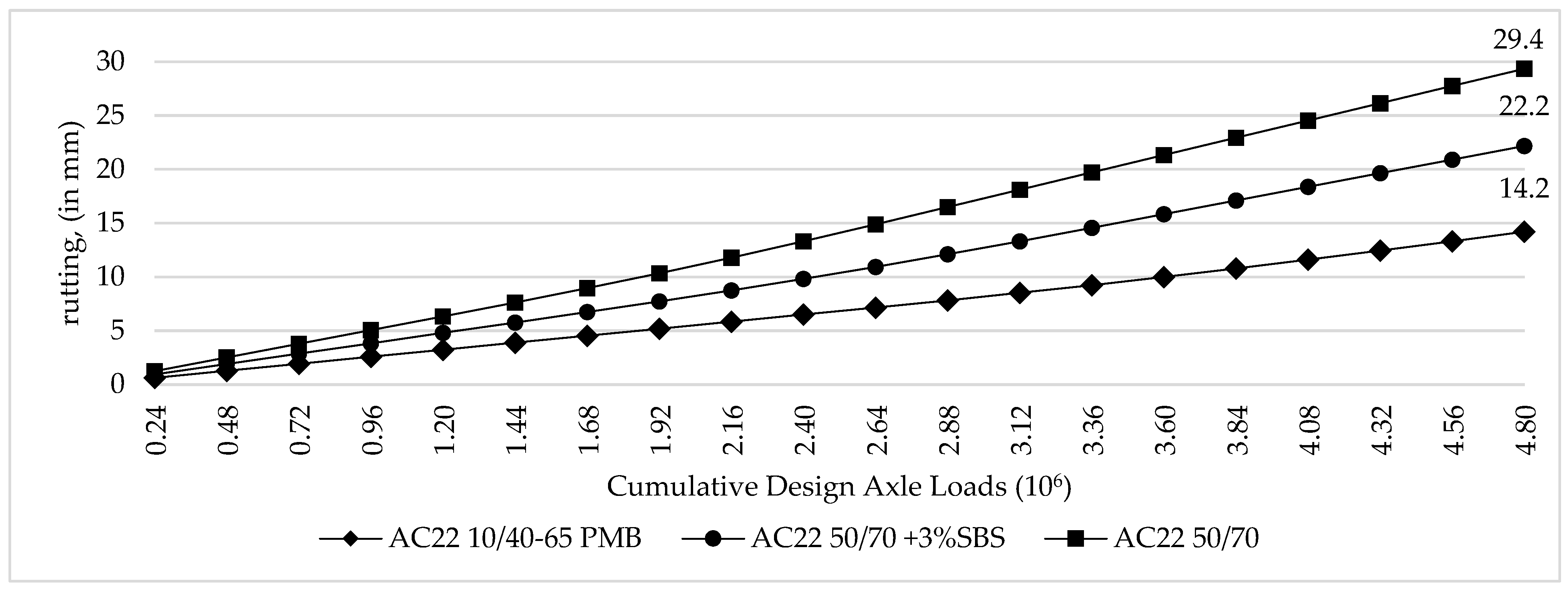
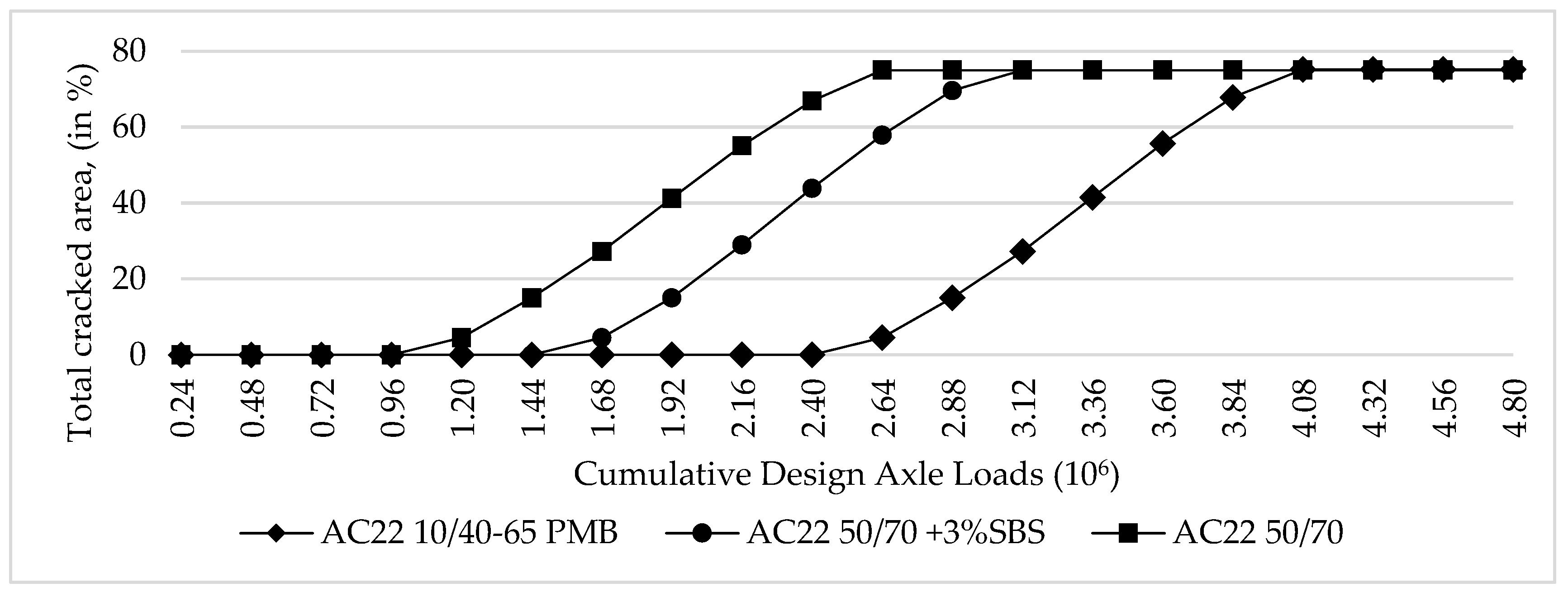
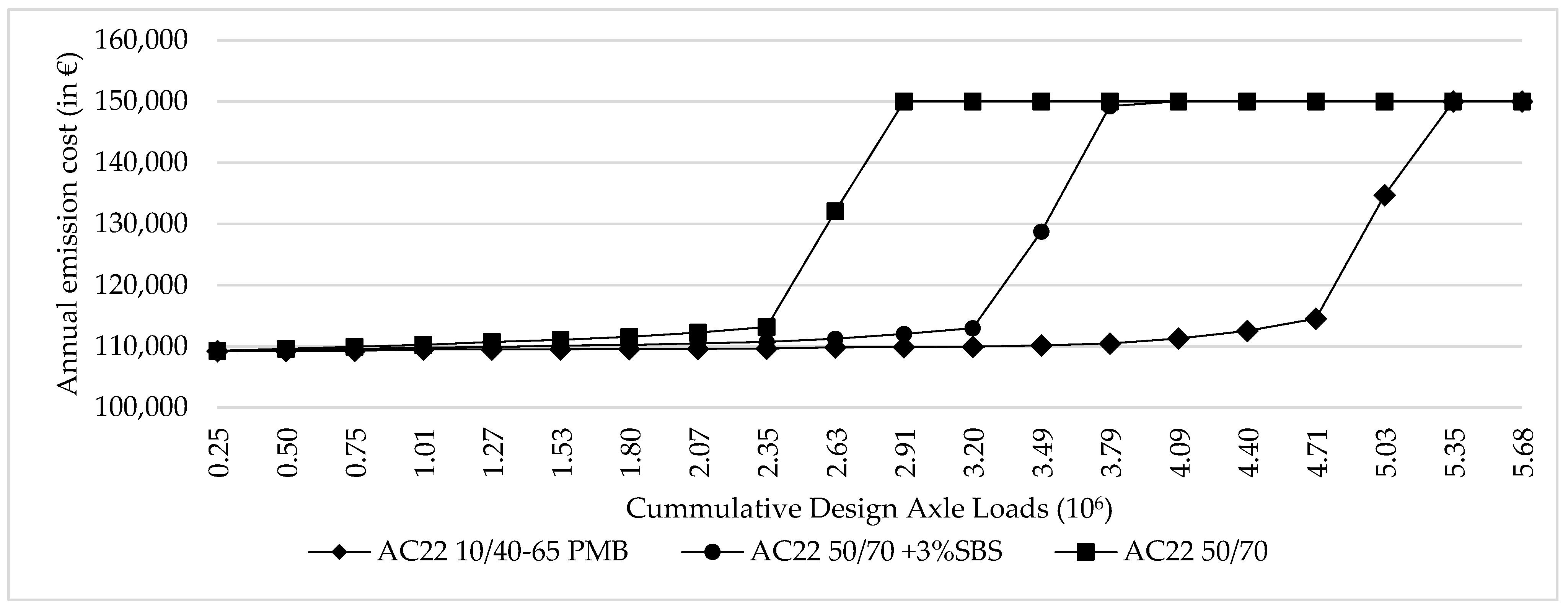


| Bitumen | Modification Dosage | Penetration (0.1 mm) | Softening Point (°C) | Elastic Recovery (%) |
|---|---|---|---|---|
| road bitumen 35/50 | 0.00% | 48 | 53.65 | 16% |
| 2.00% | 53 | 57.05 | 48% | |
| 2.50% | 51 | 57.45 | 49% | |
| 3.00% | 48 | 57.55 | 51% | |
| 3.50% | 42 | 57.60 | 54% | |
| road bitumen 50/70 | 0.00% | 67 | 49.65 | 12% |
| 2.00% | 56 | 52.30 | 23% | |
| 2.50% | 54 | 52.50 | 40% | |
| 3.00% | 47 | 52.60 | 49% | |
| 3.50% | 49 | 52.50 | 50% | |
| road bitumen 10/40–65 | - | 40 | 65.00 | 70% |
| Mixture | Max. Aggregate Size | Sample Thickness | Tempering | No. of Cycles |
|---|---|---|---|---|
| Mixture 1(SMA11) with 50/70 road bitumen + 3% of SBS modifier | 11 mm | 40 mm | 5 h | 10,000 |
| Mixture 1(SMA11) with 10/40–65 road bitumen—reference | 11 mm | 40 mm | 5 h | 10,000 |
| Mixture 2(AC11) with 50/70 road bitumen + 3% of SBS modifier | 11 mm | 40 mm | 5 h | 10,000 |
| Mixture 2(AC11) with 10/40–65 road bitumen—reference | 11 mm | 40 mm | 5 h | 10,000 |
| Mixture 3(AC22) with 50/70 road bitumen + 3% of SBS modifier | 22 mm | 80 mm | 8 h | 10,000 |
| Mixture 3(AC22) with 10/40–65 road bitumen—reference | 22 mm | 80 mm | 8 h | 10,000 |
| Bitumen | 50/70 + 3% SBS Modifier | 10/40–65 Reference |
|---|---|---|
| Test temperature | 50 °C | 50 °C |
| WTS (mm) | 0.085 mm | 0.10 mm |
| RD (mm) | 1.875 mm | 1.900 mm |
| PRD (%) | 4.68% | 4.70% |
| ɛ6 (μm) | 119 | 190 |
| Bitumen | 50/70 + 3% SBS Modifier | 10/40–65 Reference |
|---|---|---|
| Test temperature | 50 °C | 50 °C |
| WTS (mm) | 0.10 mm | 0.10 mm |
| RD (mm) | 2.280 mm | 2.050 mm |
| PRD (%) | 5.56% | 5.00% |
| ɛ6 (μm) | 115 | 125 |
| Bitumen | 50/70 + 3% SBS Modifier | 10/40–65 Reference |
|---|---|---|
| Test temperature | 50 °C | 50 °C |
| WTS (mm) | 0.145 mm | 0.07 mm |
| RD (mm) | 2.370 mm | 1.800 mm |
| PRD (%) | 3.95% | 3.00% |
| ɛ6 (μm) | 98 | 131 |
| Layer | Poisson Number | Complex Modulus |
|---|---|---|
| SMA—Stone matrix asphalt | 0.30 | 5195 MPa |
| AC22—with road bitumen 50/70 (unmodified) | 0.33 | 7130 MPa |
| AC22—with road bitumen 50/70 + 3% SBS | 0.33 | 6930 MPa |
| AC22—with road bitumen 10/40–65 | 0.33 | 6192 MPa |
| Cement stabilization C12/15 | 0.22 | 2000 MPa |
| Gravel Sub-base | 0.35 | 120 MPa |
| Subgrade | 0.35 | 60 MPa |
| Moisture Classification | Moisture Index | Duration of Dry Season | Mean Monthly Precipitation | Mean Temperature | Avg. Temperature Range | Days T > 32 °C | Freeze Index |
|---|---|---|---|---|---|---|---|
| Semiarid | −36 | 7.32 months | 54.5 mm | 9.5 °C | 20.2 °C | 19.5 days | 262 |
| Van | Medium Lorry | Medium Passenger Car | Heavy Bus | Articulated Truck | Heavy Lorry | Total | |
|---|---|---|---|---|---|---|---|
| AADT | 1471 | 42 | 4559 | 28 | 182 | 18 | 4876 |
| 20-year total | 3087 | 882 | 94,639 | 588 | 3822 | 378 | 102,396 |
| Vehicle | Nitrous Oxide | Carbon Dioxide | Sulfur Dioxide | |
|---|---|---|---|---|
| aNOx | FRNOx | aCO2 | aSO2 | |
| Light Truck | 0.0270 | 0.0000 | 1.8000 | 0.0050 |
| Medium Truck | 0.0270 | 0.0000 | 2.0000 | 0.0050 |
| Medium Car | 0.0550 | 0.1700 | 1.8000 | 0.0005 |
| Heavy Bus | 0.0270 | 0.0000 | 2.0000 | 0.0050 |
| Articulated Truck | 0.0270 | 0.0000 | 2.0000 | 0.0050 |
| Heavy Truck | 0.0270 | 0.0000 | 2.0000 | 0.0050 |
| Vehicle | a0 (×10−2) | a1 (×10−2) | a2 (×10−2) |
|---|---|---|---|
| Light Truck | −2.93 | 6.01 | 0.00 |
| Medium Truck | 1.39 | 2.90 | 0.00 |
| Medium Car | −3.92 | 4.92 | 2.00 |
| Heavy Bus | 1.39 | 2.90 | 0.00 |
| Articulated Truck | 13.7 | 2.94 | 0.00 |
| Heavy Truck | 1.39 | 2.90 | 0.00 |
| Year | Carbon Dioxide—CO2 | Sulfur Dioxide—SO2 | Nitrous Oxide—NOx | ||||||
|---|---|---|---|---|---|---|---|---|---|
| AC22 10/40–65 PMB Reference | AC22 50/70 + 3%SBS | AC22 50/70 | AC22 10/40–65 PMB Reference | AC22 50/70 + 3%SBS | AC22 50/70 | AC22 10/40–65 PMB Reference | AC22 50/70 + 3%SBS | AC22 50/70 | |
| 1 | 367.96 | 368.11 | 368.36 | 0.44 | 0.44 | 0.44 | 2.99 | 2.99 | 2.99 |
| 2 | 368.12 | 368.55 | 369.33 | 0.44 | 0.44 | 0.44 | 2.99 | 3.00 | 3.00 |
| 3 | 368.30 | 369.04 | 370.36 | 0.44 | 0.44 | 0.44 | 2.99 | 3.00 | 3.01 |
| 4 | 368.49 | 369.53 | 371.44 | 0.44 | 0.44 | 0.44 | 3.00 | 3.01 | 3.02 |
| 5 | 368.68 | 370.05 | 372.58 | 0.44 | 0.44 | 0.45 | 3.00 | 3.01 | 3.03 |
| 6 | 368.87 | 370.61 | 373.78 | 0.44 | 0.44 | 0.45 | 3.00 | 3.02 | 3.04 |
| 7 | 369.06 | 371.22 | 375.04 | 0.44 | 0.44 | 0.45 | 3.00 | 3.02 | 3.06 |
| 8 | 369.26 | 371.89 | 377.36 | 0.44 | 0.44 | 0.45 | 3.00 | 3.03 | 3.08 |
| 9 | 369.48 | 372.65 | 382.98 | 0.44 | 0.45 | 0.46 | 3.00 | 3.03 | 3.08 |
| 10 | 369.74 | 373.97 | 459.81 | 0.44 | 0.45 | 0.54 | 3.01 | 3.05 | 3.49 |
| 11 | 370.03 | 376.97 | 527.04 | 0.44 | 0.45 | 0.61 | 3.01 | 3.07 | 3.93 |
| 12 | 370.38 | 381.58 | 527.04 | 0.44 | 0.46 | 0.61 | 3.01 | 3.08 | 3.93 |
| 13 | 370.79 | 447.86 | 527.04 | 0.44 | 0.52 | 0.61 | 3.02 | 3.41 | 3.93 |
| 14 | 371.72 | 523.87 | 527.04 | 0.44 | 0.61 | 0.61 | 3.03 | 3.91 | 3.93 |
| 15 | 374.11 | 527.04 | 527.04 | 0.45 | 0.61 | 0.61 | 3.05 | 3.93 | 3.93 |
| 16 | 378.49 | 527.04 | 527.04 | 0.46 | 0.61 | 0.61 | 3.08 | 3.93 | 3.93 |
| 17 | 390.59 | 527.04 | 527.04 | 0.47 | 0.61 | 0.61 | 3.09 | 3.93 | 3.93 |
| 18 | 470.27 | 527.04 | 527.04 | 0.55 | 0.61 | 0.61 | 3.55 | 3.93 | 3.93 |
| 19 | 527.04 | 527.04 | 527.04 | 0.61 | 0.61 | 0.61 | 3.93 | 3.93 | 3.93 |
| 20 | 527.04 | 527.04 | 527.04 | 0.61 | 0.61 | 0.61 | 3.93 | 3.93 | 3.93 |
| total | 7838.42 | 8598.14 | 9091.44 | 9.31 | 10.12 | 10.66 | 62.68 | 67.21 | 70.10 |
| Year | Carbon Dioxide—CO2 | Sulfur Dioxide—SO2 | Nitrous Oxide—NOx | ||||||
|---|---|---|---|---|---|---|---|---|---|
| AC22 10/40–65 PMB Reference | AC22 50/70 + 3%SBS | AC22 50/70 | AC22 10/40–65 PMB Reference | AC22 50/70 + 3%SBS | AC22 50/70 | AC22 10/40–65 PMB Reference | AC22 50/70 + 3%SBS | AC22 50/70 | |
| 1 | 51,735 | 51,756 | 51,791 | 5289 | 5289 | 5289 | 52,205 | 52,205 | 52,205 |
| 2 | 51,758 | 51,818 | 51,928 | 5289 | 5289 | 5289 | 52,205 | 52,380 | 52,380 |
| 3 | 51,783 | 51,887 | 52,073 | 5289 | 5289 | 5289 | 52,205 | 52,380 | 52,555 |
| 4 | 51,810 | 51,956 | 52,224 | 5289 | 5289 | 5289 | 52,380 | 52,555 | 52,729 |
| 5 | 51,836 | 52,029 | 52,385 | 5289 | 5289 | 5409 | 52,380 | 52,555 | 52,904 |
| 6 | 51,863 | 52,108 | 52,553 | 5289 | 5289 | 5409 | 52,380 | 52,729 | 53,078 |
| 7 | 51,890 | 52,194 | 52,731 | 5289 | 5289 | 5409 | 52,380 | 52,729 | 53,428 |
| 8 | 51,918 | 52,288 | 53,057 | 5289 | 5289 | 5409 | 52,380 | 52,904 | 53,777 |
| 9 | 51,949 | 52,395 | 53,847 | 5289 | 5409 | 5529 | 52,380 | 52,904 | 53,777 |
| 10 | 51,985 | 52,580 | 64,649 | 5289 | 5409 | 6491 | 52,555 | 53,253 | 60,935 |
| 11 | 52,026 | 53,002 | 74,102 | 5289 | 5409 | 7332 | 52,555 | 53,602 | 68,618 |
| 12 | 52,075 | 53,650 | 74,102 | 5289 | 5529 | 7332 | 52,555 | 53,777 | 68,618 |
| 13 | 52,133 | 62,969 | 74,102 | 5289 | 6250 | 7332 | 52,729 | 59,539 | 68,618 |
| 14 | 52,264 | 73,656 | 74,102 | 5289 | 7332 | 7332 | 52,904 | 68,269 | 68,618 |
| 15 | 52,600 | 74,102 | 74,102 | 5409 | 7332 | 7332 | 53,253 | 68,618 | 68,618 |
| 16 | 53,216 | 74,102 | 74,102 | 5529 | 7332 | 7332 | 53,777 | 68,618 | 68,618 |
| 17 | 54,917 | 74,102 | 74,102 | 5649 | 7332 | 7332 | 53,951 | 68,618 | 68,618 |
| 18 | 66,120 | 74,102 | 74,102 | 6611 | 7332 | 7332 | 61,983 | 68,618 | 68,618 |
| 19 | 74,102 | 74,102 | 74,102 | 7332 | 7332 | 7332 | 68,618 | 68,618 | 68,618 |
| 20 | 74,102 | 74,102 | 74,102 | 7332 | 7332 | 7332 | 68,618 | 68,618 | 68,618 |
| total | 1,102,082 | 1,208,898 | 1,278,256 | 111,906 | 121,642 | 128,133 | 1,094,393 | 1,173,487 | 1,223,946 |
Disclaimer/Publisher’s Note: The statements, opinions and data contained in all publications are solely those of the individual author(s) and contributor(s) and not of MDPI and/or the editor(s). MDPI and/or the editor(s) disclaim responsibility for any injury to people or property resulting from any ideas, methods, instructions or products referred to in the content. |
© 2024 by the authors. Licensee MDPI, Basel, Switzerland. This article is an open access article distributed under the terms and conditions of the Creative Commons Attribution (CC BY) license (https://creativecommons.org/licenses/by/4.0/).
Share and Cite
Kozel, M.; Remek, Ľ.; Mikolaj, J.; Mušuta, J.; Šrámek, J.; Mazurek, G. Performance and Lifecycle of Hot Asphalt Mix Modified with Low-Percentage Polystyrene and Polybutadiene Compounds. Buildings 2024, 14, 389. https://doi.org/10.3390/buildings14020389
Kozel M, Remek Ľ, Mikolaj J, Mušuta J, Šrámek J, Mazurek G. Performance and Lifecycle of Hot Asphalt Mix Modified with Low-Percentage Polystyrene and Polybutadiene Compounds. Buildings. 2024; 14(2):389. https://doi.org/10.3390/buildings14020389
Chicago/Turabian StyleKozel, Matúš, Ľuboš Remek, Ján Mikolaj, Juraj Mušuta, Juraj Šrámek, and Grzegorz Mazurek. 2024. "Performance and Lifecycle of Hot Asphalt Mix Modified with Low-Percentage Polystyrene and Polybutadiene Compounds" Buildings 14, no. 2: 389. https://doi.org/10.3390/buildings14020389
APA StyleKozel, M., Remek, Ľ., Mikolaj, J., Mušuta, J., Šrámek, J., & Mazurek, G. (2024). Performance and Lifecycle of Hot Asphalt Mix Modified with Low-Percentage Polystyrene and Polybutadiene Compounds. Buildings, 14(2), 389. https://doi.org/10.3390/buildings14020389







